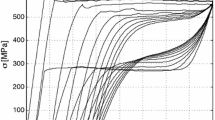Abstract
We present a micromechanical model for polycrystalline shape-memory alloys which is capable of reproducing important aspects of the material behavior such as pseudoelasticity, pseudoplasticity, tension–compression asymmetry and the influence of texture inhomogeneities which may occur from the production process of components or specimens. Our model is based on the optimization of the material’s free energy density and uses a dissipation ansatz which is homogeneous of first order. Considering the full anisotropic material properties of both the austenite and the martensite phase, we compute the evolution of the orientation distributions of austenite and martensite as internal variables of our model.
Similar content being viewed by others
References
Ball J.M. and James R.D. (1987). Fine phase mixtures as minimizers of energy. Arch. Rat. Mech. Anal. 100: 13–52
Bhattacharya and K. (2003). Microstructure of Martensite. Why it Forms and How it Gives Rise to the Shape-memory Effect. Oxford University Press, New York
Bhattacharya K. and Kohn R. (1996). Symmetry, texture and the recoverable strain of shape-memory polycrystals. Acta Mater. 44: 529–542
Carstensen C., Hackl K. and Mielke A. (2002). Nonconvex potentials and microstructure in finite-strain plasticity. Proc. R. Soc. Lond. A 458: 299–317
Carstensen C. and Plechd́fc̆ P. (2001). Numerical analysis of a relaxed variational model of hysteresis in two-phase solids. M2AN Math. Model. Numer. Anal. 35: 865–878
Dacorogna B. (1982). Quasiconvexity and relaxation of nonconvex problems in the calculus of variations. J. Funct. Anal. 46: 102–118
Govindjee S., Hackl K. and Heinen R. (2007). An upper bound to the free energy of mixing by twin-compatible lamination for n-variant martensitic phase transformations. Continuum Mech. Thermodyn. 18: 443–453
Govindjee S. and Miehe C. (2001). A multi-variant martensitic phase transformation model: formulation and numerical implementation. Comput. Methods Appl. Mech. Eng. 191: 215–238
Grabe, C., Bruhns, O.T.: Tension/torsion tests of pseudoelastic, polycrystalline NiTi shape memory alloys under temperature control. Mat. Sci. Eng. A, doi:10.1016/j.msea.2007.03.117 (2007)
Hackl K. and Fischer F.D. (2008). On the relation between the principle of maximum dissipation and inelastic evolution given by dissipation potentials. Proc. R. Soc. A 464: 117–132
Hackl, K., Heinen, R., Schmahl, W.W., Hasan, M.: Experimental verification of a micromechanical model for polycrystalline shape memory alloys in dependence of martensite orientation distributions. Mat. Sci. Eng. A. doi:10.1016/j.msea.2006.10.218 (2007)
Hackl K. and Hoppe U. (2003). On the calculation of microstructures for inelastic materials using relaxed energies. In: Miehe, C. (eds) Proceedings of the IUTAM Symposium on Computational Mechanics of Solid Materials at Large Strains, pp 77–86. Kluwer, Boston
Hackl K., Schmidt-Baldassari M. and Zhang W. (2004). A micromechanical model for polycrystalline shape-memory alloys. Mater. Sci. Eng. A 378: 503–506
Heinen R. and Hackl K. (2007). On the calculation of energy-minimizing phase fractions in shape memory alloys. Comput. Methods Appl. Mech. Eng. 196: 2401–2412
Huo Y. and Müller I. (1993). Nonequilibrium thermodynamics of pseudoelasticity. Contin. Mech. Thermodyn. 5: 163–204
Kohn R. (1991). The relaxation of a double-well problem. Contin. Mech. Thermodyn. 3: 193–236
Mielke A. (2003). Energetic formulation of multiplicative elasto-plasticity using dissipation distances. Contin. Mech. Thermodyn. 15: 351–382
Mielke A., Theil F. and Levitas V.I. (2002). A variational formulation of rate-independent phase transformations using an extremum principle. Arch. Rat. Mech. Anal. 162: 137–177
Moreau J.J. (1963). Fonctionelles sous-différentiables. C. R. Acad. Sci. Paris, Série A 257: 4117–4119
Ortiz M. and Repetto E.A. (1999). Nonconvex energy minimization and dislocation structures in ductile single crystals. J. Mech. Phys. Solids 47: 397–462
Ortiz M. and Stainier L. (1999). The variational formulation of viscoplastic constitutive updates. Comput. Methods Appl. Mech. Eng. 171: 419–444
Otsuka K. and Wayman C.M. (1999). Shape Memory Materials. Cambridge University Press, Cambridge
Roubf́8ček, T.: Relaxation in Optimization Theory and Variational Calculus. De Gruyter, Berlin (1997)
Sedlák P., Seiner H., Landa M., Novák V., Sittner P. and Mañosa Ll. (2005). Elastic constants of bcc austenite and 2H orthorhombic martensite in CuAlNi shape memory alloy. Acta Mater. 53: 3643–3661
Schmahl W.W., Khalil-Allafi J., Hasse B., Wagner M., Heckmann A. and Somsen Ch. (2004). Investigation of the phase evolution in a super-elastic NiTi shape memory alloy (50.7 at.%Ni) under extensional load with synchrotron radiation. Mater. Sci. Eng. A 378: 81–85
Smyshlyaev V. and Willis J. (1998). On the relaxation of a three-well energy. Proc. R. Soc. Lond. A 455: 779–814
Frenzel, J., Pfetzing, J., Neuking, K., Eggeler, G.: On the influence of thermomechanical treatments on the microstructure and phase transformation behavior of Ni-Ti-Fe shape memory alloys. Mat. Sci. Eng. A, doi:10.1016/j.msea.2007.03.115 (2007)
Author information
Authors and Affiliations
Corresponding author
Additional information
Communicated by M. Ortiz
Rights and permissions
About this article
Cite this article
Hackl, K., Heinen, R. A micromechanical model for pretextured polycrystalline shape-memory alloys including elastic anisotropy. Continuum Mech. Thermodyn. 19, 499–510 (2008). https://doi.org/10.1007/s00161-008-0067-z
Received:
Accepted:
Published:
Issue Date:
DOI: https://doi.org/10.1007/s00161-008-0067-z




